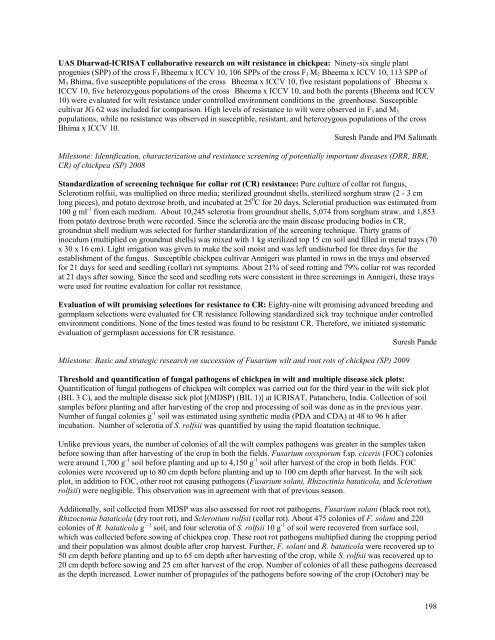ICRISAT Archival Report 2006 - The seedlings of success in the ...
ICRISAT Archival Report 2006 - The seedlings of success in the ...
ICRISAT Archival Report 2006 - The seedlings of success in the ...
Create successful ePaper yourself
Turn your PDF publications into a flip-book with our unique Google optimized e-Paper software.
UAS Dharwad-<strong>ICRISAT</strong> collaborative research on wilt resistance <strong>in</strong> chickpea: N<strong>in</strong>ety-six s<strong>in</strong>gle plant<br />
progenies (SPP) <strong>of</strong> <strong>the</strong> cross F 3 Bheema x ICCV 10, 106 SPPs <strong>of</strong> <strong>the</strong> cross F 3 M 2 Bheema x ICCV 10, 113 SPP <strong>of</strong><br />
M 3 Bhima, five susceptible populations <strong>of</strong> <strong>the</strong> cross Bheema x ICCV 10, five resistant populations <strong>of</strong> Bheema x<br />
ICCV 10, five heterozygous populations <strong>of</strong> <strong>the</strong> cross Bheema x ICCV 10, and both <strong>the</strong> parents (Bheema and ICCV<br />
10) were evaluated for wilt resistance under controlled environment conditions <strong>in</strong> <strong>the</strong> greenhouse. Susceptible<br />
cultivar JG 62 was <strong>in</strong>cluded for comparison. High levels <strong>of</strong> resistance to wilt were observed <strong>in</strong> F 3 and M 3<br />
populations, while no resistance was observed <strong>in</strong> susceptible, resistant, and heterozygous populations <strong>of</strong> <strong>the</strong> cross<br />
Bhima x ICCV 10.<br />
Suresh Pande and PM Salimath<br />
Milestone: Identification, characterization and resistance screen<strong>in</strong>g <strong>of</strong> potentially important diseases (DRR, BRR,<br />
CR) <strong>of</strong> chickpea (SP) 2008<br />
Standardization <strong>of</strong> screen<strong>in</strong>g technique for collar rot (CR) resistance: Pure culture <strong>of</strong> collar rot fungus,<br />
Sclerotium rolfsii, was multiplied on three media; sterilized groundnut shells, sterilized sorghum straw (2 - 3 cm<br />
long pieces), and potato dextrose broth, and <strong>in</strong>cubated at 25 0 C for 20 days. Sclerotial production was estimated from<br />
100 g ml -1 from each medium. About 10,245 sclerotia from groundnut shells, 5,074 from sorghum straw, and 1,853<br />
from potato dextrose broth were recorded. S<strong>in</strong>ce <strong>the</strong> sclerotia are <strong>the</strong> ma<strong>in</strong> disease produc<strong>in</strong>g bodies <strong>in</strong> CR,<br />
groundnut shell medium was selected for fur<strong>the</strong>r standardization <strong>of</strong> <strong>the</strong> screen<strong>in</strong>g technique. Thirty grams <strong>of</strong><br />
<strong>in</strong>oculum (multiplied on groundnut shells) was mixed with 1 kg sterilized top 15 cm soil and filled <strong>in</strong> metal trays (70<br />
x 30 x 16 cm). Light irrigation was given to make <strong>the</strong> soil moist and was left undisturbed for three days for <strong>the</strong><br />
establishment <strong>of</strong> <strong>the</strong> fungus. Susceptible chickpea cultivar Annigeri was planted <strong>in</strong> rows <strong>in</strong> <strong>the</strong> trays and observed<br />
for 21 days for seed and seedl<strong>in</strong>g (collar) rot symptoms. About 21% <strong>of</strong> seed rott<strong>in</strong>g and 79% collar rot was recorded<br />
at 21 days after sow<strong>in</strong>g. S<strong>in</strong>ce <strong>the</strong> seed and seedl<strong>in</strong>g rots were consistent <strong>in</strong> three screen<strong>in</strong>gs <strong>in</strong> Annigeri, <strong>the</strong>se trays<br />
were used for rout<strong>in</strong>e evaluation for collar rot resistance.<br />
Evaluation <strong>of</strong> wilt promis<strong>in</strong>g selections for resistance to CR: Eighty-n<strong>in</strong>e wilt promis<strong>in</strong>g advanced breed<strong>in</strong>g and<br />
germplasm selections were evaluated for CR resistance follow<strong>in</strong>g standardized sick tray technique under controlled<br />
environment conditions. None <strong>of</strong> <strong>the</strong> l<strong>in</strong>es tested was found to be resistant CR. <strong>The</strong>refore, we <strong>in</strong>itiated systematic<br />
evaluation <strong>of</strong> germplasm accessions for CR resistance.<br />
Suresh Pande<br />
Milestone: Basic and strategic research on <strong>success</strong>ion <strong>of</strong> Fusarium wilt and root rots <strong>of</strong> chickpea (SP) 2009<br />
Threshold and quantification <strong>of</strong> fungal pathogens <strong>of</strong> chickpea <strong>in</strong> wilt and multiple disease sick plots:<br />
Quantification <strong>of</strong> fungal pathogens <strong>of</strong> chickpea wilt complex was carried out for <strong>the</strong> third year <strong>in</strong> <strong>the</strong> wilt sick plot<br />
(BIL 3 C), and <strong>the</strong> multiple disease sick plot [(MDSP) (BIL 1)] at <strong>ICRISAT</strong>, Patancheru, India. Collection <strong>of</strong> soil<br />
samples before plant<strong>in</strong>g and after harvest<strong>in</strong>g <strong>of</strong> <strong>the</strong> crop and process<strong>in</strong>g <strong>of</strong> soil was done as <strong>in</strong> <strong>the</strong> previous year.<br />
Number <strong>of</strong> fungal colonies g -1 soil was estimated us<strong>in</strong>g syn<strong>the</strong>tic media (PDA and CDA) at 48 to 96 h after<br />
<strong>in</strong>cubation. Number <strong>of</strong> sclerotia <strong>of</strong> S. rolfsii was quantified by us<strong>in</strong>g <strong>the</strong> rapid floatation technique.<br />
Unlike previous years, <strong>the</strong> number <strong>of</strong> colonies <strong>of</strong> all <strong>the</strong> wilt complex pathogens was greater <strong>in</strong> <strong>the</strong> samples taken<br />
before sow<strong>in</strong>g than after harvest<strong>in</strong>g <strong>of</strong> <strong>the</strong> crop <strong>in</strong> both <strong>the</strong> fields. Fusarium oxysporum f.sp. ciceris (FOC) colonies<br />
were around 1,700 g -1 soil before plant<strong>in</strong>g and up to 4,150 g -1 soil after harvest <strong>of</strong> <strong>the</strong> crop <strong>in</strong> both fields. FOC<br />
colonies were recovered up to 80 cm depth before plant<strong>in</strong>g and up to 100 cm depth after harvest. In <strong>the</strong> wilt sick<br />
plot, <strong>in</strong> addition to FOC, o<strong>the</strong>r root rot caus<strong>in</strong>g pathogens (Fusarium solani, Rhizoct<strong>in</strong>ia bataticola, and Sclerotium<br />
rolfsii) were negligible. This observation was <strong>in</strong> agreement with that <strong>of</strong> previous season.<br />
Additionally, soil collected from MDSP was also assessed for root rot pathogens, Fusarium solani (black root rot),<br />
Rhizoctonia bataticola (dry root rot), and Sclerotium rolfsii (collar rot). About 475 colonies <strong>of</strong> F. solani and 220<br />
colonies <strong>of</strong> R. bataticola g –1 soil, and four sclerotia <strong>of</strong> S. rolfsii 10 g -1 <strong>of</strong> soil were recovered from surface soil,<br />
which was collected before sow<strong>in</strong>g <strong>of</strong> chickpea crop. <strong>The</strong>se root rot pathogens multiplied dur<strong>in</strong>g <strong>the</strong> cropp<strong>in</strong>g period<br />
and <strong>the</strong>ir population was almost double after crop harvest. Fur<strong>the</strong>r, F. solani and R. bataticola were recovered up to<br />
50 cm depth before plant<strong>in</strong>g and up to 65 cm depth after harvest<strong>in</strong>g <strong>of</strong> <strong>the</strong> crop, while S. rolfsii was recovered up to<br />
20 cm depth before sow<strong>in</strong>g and 25 cm after harvest <strong>of</strong> <strong>the</strong> crop. Number <strong>of</strong> colonies <strong>of</strong> all <strong>the</strong>se pathogens decreased<br />
as <strong>the</strong> depth <strong>in</strong>creased. Lower number <strong>of</strong> propagules <strong>of</strong> <strong>the</strong> pathogens before sow<strong>in</strong>g <strong>of</strong> <strong>the</strong> crop (October) may be<br />
198

















